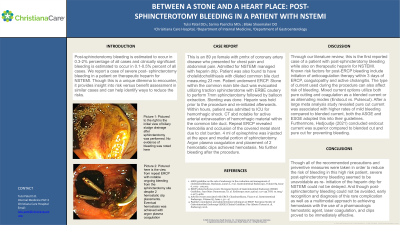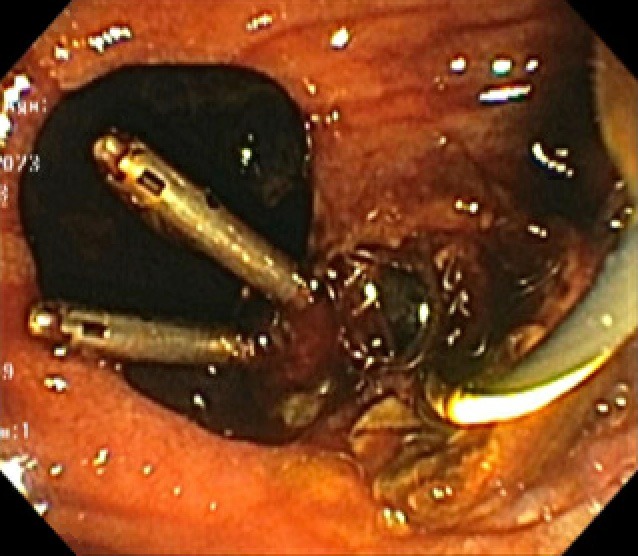Tuesday Poster Session
Category: Interventional Endoscopy
P4515 - Between a Stone and a Heart Place: Post-Sphincterotomy Bleeding in a Patient With NSTEMI
Tuesday, October 29, 2024
10:30 AM - 4:00 PM ET
Location: Exhibit Hall E

.jpg)
Tulsi Patel, DO
Christiana Care Health System
Elk Grove Village, IL
Presenting Author(s)
Tulsi Patel, DO1, Sarina Pasricha, MD2, Blake Shoemaker, DO2
1Christiana Care Health System, Elk Grove Village, IL; 2Christiana Care Health System, Newark, DE
Introduction:
Post-sphincterotomy bleeding is estimated to occur in 0.3-2% percentage of all cases and clinically significant bleeding is estimated to occur in 0.1-0.5% percent of all cases. We report a case of severe post- sphincterotomy bleeding in a patient on therapeutic heparin for NSTEMI. Though this is a unique dilemma to encounter, it provides insight into risk versus benefit assessment in similar cases.
Case Description/Methods:
This 89 yo female with pmhx of CAD presented for chest pain and abdominal pain. Admitted for NSTEMI managed with heparin drip. Patient was also found to have cholelidocholithiasis with dilated common bile duct measuring 23 mm. During ERCP, stone within the common main bile duct was evacuated utilizing traction sphincterotome with ERBE cautery to perform 7mm sphincterotomy followed by balloon extraction and stenting. Heparin was held prior to the procedure and re-initiated after. Within hours, patient developed hemorrhagic shock. CT abd notable for active arterial extravasation of hemorrhagic material within the common bile duct. Repeat ERCP revealed hemobilia and occlusion of the covered metal stent from clot burden. 4 ml of epinephrine was injected at the apex and medial portion of sphincterotomy. Argon plasma coagulation and placement of 2 hemostatic clips achieved hemostasis. No further bleeding after the procedure.
Discussion:
Known risk factors for post-ERCP bleeding include initiation of anticoagulation therapy within 3 days of ERCP, coagulopathy and active cholangitis. The type of current used during the procedure can also affect risk of bleeding. Mixed current options utilize both pure cutting and coagulation as a blended current or as alternating modes. After a large meta analysis revealed pure cut was associated with higher rates of bleeding compared to blended current, both the ASGE and ESGE adopted this into their guidelines. Furthermore, Hedjoudje (2021) concluded endocut current was superior to blended cut and pure cut in preventing bleeding.
Though all of the recommended precautions and preventive measures were taken in order to reduce the risk of bleeding in this high risk patient, severe post-sphincterotomy bleeding seemed to be unavoidable as re- initiation of the heparin drip for NSTEMI could not be delayed. This case exemplifies how early recognition and diagnosis of this rare complication as well as a multimodal approach to achieving hemostasis with the use of a pharmacologic hemostatic agent, laser coagulation, and clips proved to be effective.

Disclosures:
Tulsi Patel, DO1, Sarina Pasricha, MD2, Blake Shoemaker, DO2. P4515 - Between a Stone and a Heart Place: Post-Sphincterotomy Bleeding in a Patient With NSTEMI, ACG 2024 Annual Scientific Meeting Abstracts. Philadelphia, PA: American College of Gastroenterology.
1Christiana Care Health System, Elk Grove Village, IL; 2Christiana Care Health System, Newark, DE
Introduction:
Post-sphincterotomy bleeding is estimated to occur in 0.3-2% percentage of all cases and clinically significant bleeding is estimated to occur in 0.1-0.5% percent of all cases. We report a case of severe post- sphincterotomy bleeding in a patient on therapeutic heparin for NSTEMI. Though this is a unique dilemma to encounter, it provides insight into risk versus benefit assessment in similar cases.
Case Description/Methods:
This 89 yo female with pmhx of CAD presented for chest pain and abdominal pain. Admitted for NSTEMI managed with heparin drip. Patient was also found to have cholelidocholithiasis with dilated common bile duct measuring 23 mm. During ERCP, stone within the common main bile duct was evacuated utilizing traction sphincterotome with ERBE cautery to perform 7mm sphincterotomy followed by balloon extraction and stenting. Heparin was held prior to the procedure and re-initiated after. Within hours, patient developed hemorrhagic shock. CT abd notable for active arterial extravasation of hemorrhagic material within the common bile duct. Repeat ERCP revealed hemobilia and occlusion of the covered metal stent from clot burden. 4 ml of epinephrine was injected at the apex and medial portion of sphincterotomy. Argon plasma coagulation and placement of 2 hemostatic clips achieved hemostasis. No further bleeding after the procedure.
Discussion:
Known risk factors for post-ERCP bleeding include initiation of anticoagulation therapy within 3 days of ERCP, coagulopathy and active cholangitis. The type of current used during the procedure can also affect risk of bleeding. Mixed current options utilize both pure cutting and coagulation as a blended current or as alternating modes. After a large meta analysis revealed pure cut was associated with higher rates of bleeding compared to blended current, both the ASGE and ESGE adopted this into their guidelines. Furthermore, Hedjoudje (2021) concluded endocut current was superior to blended cut and pure cut in preventing bleeding.
Though all of the recommended precautions and preventive measures were taken in order to reduce the risk of bleeding in this high risk patient, severe post-sphincterotomy bleeding seemed to be unavoidable as re- initiation of the heparin drip for NSTEMI could not be delayed. This case exemplifies how early recognition and diagnosis of this rare complication as well as a multimodal approach to achieving hemostasis with the use of a pharmacologic hemostatic agent, laser coagulation, and clips proved to be effective.

Figure: Pictured is the post-spincterotomy site after placement of hemostatic clips and biliary stent
Disclosures:
Tulsi Patel indicated no relevant financial relationships.
Sarina Pasricha indicated no relevant financial relationships.
Blake Shoemaker indicated no relevant financial relationships.
Tulsi Patel, DO1, Sarina Pasricha, MD2, Blake Shoemaker, DO2. P4515 - Between a Stone and a Heart Place: Post-Sphincterotomy Bleeding in a Patient With NSTEMI, ACG 2024 Annual Scientific Meeting Abstracts. Philadelphia, PA: American College of Gastroenterology.
